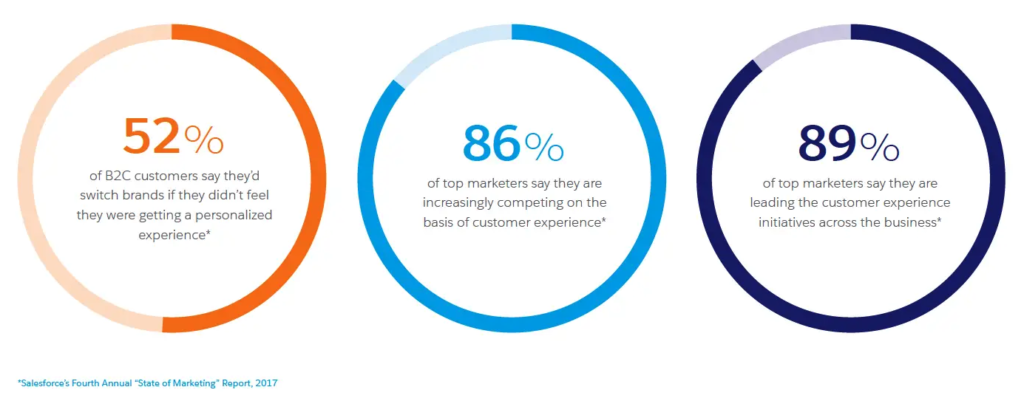How Personalization is Impacting Experiential Marketing

We live in an on-demand world. The mobile revolution that was anticipated for so long is now very much a reality. Within seconds, virtually anything your heart desires can be purchased and delivered to your preferred location. Whether you’re looking for dinner and a movie or a custom pair of shoes, it’s all just a click away!
Is it any wonder that everyone has suddenly raised their expectations for the speed and quality of their daily interactions?
As the bar continues to rise, the latest upgrade to our lifestyles are products, services, and experiences that aren’t just readily accessible but also highly customized to our individual needs and tastes.
BIG DATA, BIG INSIGHTS
Much is said about the value of collecting data. Every app, website, and experience today want to convince users to input as much personally relevant information as possible. But less is said about how to convert the fruits of that labor into actionable insights and create real-world value.
How does knowing your audience’s demographics, its browsing history, and its subjective likes and dislikes translate into meaningful performance indicators like increased foot traffic and engagement levels?

The increased expectation for personalization and customization provides some insight. Fast-moving companies spot trends, discover needs that are going unfulfilled, and create executions that are finely tailored to these hyper-specific use cases — and if they are nimble and shrewd, their brand wins a first-mover advantage, earns thought leader status, and differentiates itself from competitors that are still doing things the old, slow, and standardized ways.
Take Amazon and Netflix for example. Both are ravenous consumers of user data. They continually feed that intelligence into their recommendation engines to provide the best possible user experience, one that treats each of several million users as individuals, with a deep understanding of their particular wants.
If a diehard horror fan logged into Netflix and everything on their homepage was a romantic comedy, they would hardly consider their experience well tailored to them. Amazon, likewise, wouldn’t make many sales by recommending car accessories to a city dweller that gets around everywhere on a bike. But, that’s definitely not the case, as over a third of Amazon revenue is directly tied to its recommendation engine.
Data isn’t valuable when it’s left in a silo, it creates positive results by directing actions.
PERSONALIZED EXPERIENCES LEADING THE CHARGE
The same currents that are propelling a shift in the digital arena are also having an impact on encounters in an increasingly connected physical world. With e-commerce pulling more attention and dollars away from brick and mortar operations every year, the brands that are thriving today are adapting by upgrading their physical experiences with their own bag of digital magic tricks.
One of the most promising technologies to emerge has been augmented reality (AR). These systems overlay digital information on top of the real world. The simplest examples, like Snapchat lenses, use nothing more than a smartphone and its camera. But others go even further to remove even that small amount of distance between the user and the world.
Fashion designer Rebecca Minkoff has been winning acclaim and boosting sales at her Connected Store in New York City thanks to the revolutionary ‘magic mirrors.’ These seemingly ordinary mirrors are actually touchscreen-enabled computers in disguise. Shoppers have full interactive control over their fitting rooms. With the touch of the mirror, they can browse the shop’s wares, request an item be sent to their room, control the lighting, even order a beverage.
Artificial intelligence is another incredible technology that is facilitating truly personalized experiences. To get his fans pumped for the release of his new book, “LIFE = CRAZY,” Top DJ Martin Garrix teamed up with Microsoft to create an immersive and unique AI-based multimedia performance.
Visitors submitted photos of themselves that were automatically analyzed, classified, and tagged. “Then, Microsoft’s Cognitive Services compared the selfie with the images in the archive, pulling up a variety of Garrix’s photos that are visually related to create a totally customized fan experience.” The final result was projected onto a mirrored hallway where the visitors were surrounded by a dazzling spectacle that connected them intimately to the star and his work.
Nike, no stranger to high tech either, ingrained features formerly confined to mobile phones all across its new NYC flagship store, the House of Innovation. Virtually everything in the store from the products to the artwork to the mannequins can be scanned and recognized by the Nike app, giving shoppers detailed information and the ability to request an in-store representative to bring them the item in their size and desired colorway. For those living the DIY lifestyle, the store also has in-house designers that will assist shoppers with major alterations.
Nike also made their showcase shopping experience customizable for their own purposes. The actual floor and wall tiles are fully modular and can be replaced quickly when they decide it’s time for a new look or if they have a product launch they want to highlight directly in the building’s structure.
At last year’s Boston Marathon, rival athletic brand Adidas deployed an array of technologies to create personalized experiences for each of the 30,000 registered runners in record time. Their “Here to Create Legend” campaign relied on location-based data derived from radio-frequency identification (RFID) chips embedded in the racers’ bibs. Geotagged footage of the race taken by an 18-person production crew was then linked to the participants’ location data to rapidly produce a unique video for each runner.
According to Idomoo, 57% of the runners who finished the race watched their video, 25% shared it on Facebook, and 80,000 visitors were directed to Adidas’ web sites.
CONSUMER AS COLLABORATOR
Part of the reason mass customization is so appealing to end users is that a more direct inclusion in the creation process gives them the ability to get exactly what they want, makes them feel a sense of meaningful involvement and a vested interest in the fruits of their labor, and enhances the overall experience by making it interactive rather than passive.
Furthermore, consumers are repositories of valuable knowledge themselves. Collaborating with them reveals pain points your product team may have overlooked, efficiencies that have gone underexploited, and new avenues for experimentation.
Firms that produce things naturally have a high level of experience and sophistication when it comes to making the kind of choices that determine the makeup of an end product. Users typically don’t. They may know what they like and what they need but have little understanding of the necessary tradeoffs that occur whenever you make a decision.
Adding that sunroof improves the roadgoing experience to your car but it adds cost, weight, and complexity. Configurators, design systems that advise laypersons and guide them around incompatible choices, are one of the more popular ways brands deliver customization at scale to consumers.
One of the best configurator systems around was built by Nike way back in 1999. When NikeiD was launched, it permitted shoppers to customize just a single style of sneaker. Today dozens of models of shoes, as well as a number of clothing items, can be fully personalized down to individual component parts, materials, and monogrammed stitching.
A number of brands now offer similar features, and users are growing to expect a wide range of customization options.
Consider the example of Nintendo’s “Mario Maker” series of video games. Players can use the game’s construction tools to build their own Super Mario game levels. Nintendo creates a platform for them to share and comment on their creations, but the community collectively decides which will receive the most attention.
By comparison, level designing tools are also available in the “Little Big Planet” series of platforming games for the PlayStation console, but parent company Sony decides which to reward with prominent placement.
Whatever system you choose to employ, it’s important to remember that the customization process isn’t just about the end product, it’s an opportunity to inject interactivity into the experience, which is a proven means of increasing user engagement. When the journey is interesting, getting there is half the fun.
ONE SIZE NO LONGER FITS ALL
As goods and services are becoming increasingly commoditized and available from a wide number of similar providers, customized options are seen as a differentiation point that attracts attention. Forrester Research found that a personalized experience leads to a 76% increase in customer engagement and a threefold increase in purchase intent.
Business consultancy Deloitte also studied this growing trend and found that more than half of consumers expressed interest in customized products and services, and just as many indicated that they would pay more for them. Additionally, their study reported that consumers liked the idea of being actively involved in the customization process.
It’s plain to see that people prefer their goods, services, and experiences tailored to their needs. No one wants to be treated like a faceless number, and now the tools and expertise to provide truly customized experiences at scale are finally within reach.
We are a unique collective of ambitious makers, doers, and dreamers that work as one to push forward the power of what’s possible.
FG|PG was founded nearly 21 years ago. Today we’re one of the largest woman-owned, WBENC Certified, live, hybrid and virtual experiential agencies in the US. That trajectory isn’t accidental. It’s the result of a commitment to continually evolve, to never stop learning, and to always listen to our clients’ needs.